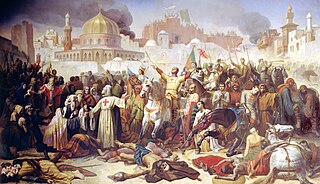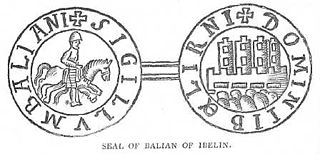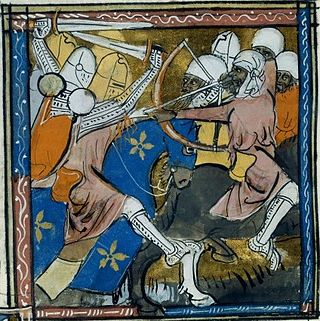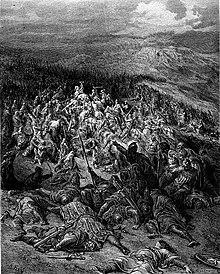Background
The town of Ramla lay on the road from Jerusalem to Ascalon, the latter of which was the largest Fatimid fortress in Palestine. From Ascalon the Fatimid vizier, Al-Afdal Shahanshah, launched almost annual attacks into the newly founded Crusader kingdom from 1099 to 1107. It was thrice the case that the two armies met each other at Ramla.
Egyptian armies of the period relied on masses of Sudanese bowmen supported by Arab and Berber cavalry. Since the archers were on foot and the horsemen awaited attack with lance and sword, an Egyptian army provided exactly the sort of immobile target that the Frankish heavy cavalry excelled in attacking. Whereas the Crusaders developed a healthy respect for the harass and surround tactics of the Turkish horse archers, they tended to discount the effectiveness of the Egyptian armies. While overconfidence led to a Crusader disaster at the second battle of Ramla, the more frequent result was a Fatimid defeat. "The Franks never, until the reign of Saladin, feared the Egyptian as they did the armies from Muslim Syria and Mesopotamia."
Battle
The surprising victory of the crusaders at the first Battle of Ramla the previous year, al-Afdal was soon ready to strike at the crusaders once again and dispatched around 20,000 troops under the command of his son Sharaf al-Ma'ali. Baldwin I of Jerusalem was in Jaffa seeing off survivors of the defeated Crusade of 1101, when news reached him of the Fatimid invasion force. William of Aquitaine had already departed, but many others such as Stephen of Blois and Count Stephen of Burgundy had been forced back due to unfavorable winds and consequently joined Baldwin's force in order to help in the battle. Due to faulty reconnaissance Baldwin severely underestimated the size of the Egyptian army, believing it to be no more than a minor expeditionary force, and rode to face an army of several thousand with only two hundred mounted knights and no infantry. [5]
Realizing his error too late and already cut off from escape, Baldwin and his army were charged by the Egyptian forces and many were quickly slaughtered, although Baldwin and a handful of others managed to barricade themselves in Ramla's single tower. Baldwin was left with no other option than to flee and escaped the tower under the cover of night with just his scribe and a single knight, Hugh of Brulis, who is never mentioned in any source afterwards. Baldwin spent the next two days evading Fatimid search parties until he arrived exhausted, starved, and parched in the reasonably safe haven of Arsuf on May 19. [5]
The situation of the remaining knights in Ramla deteriorated when Fatimid forces stormed the town on the morning after Baldwin's escape, with only the tower remaining under Crusader control. The Fatimids ruthlessly attacked the tower, undermining walls and setting fires to smoke out the desperate defenders. After a day of desperately holding their ground the remaining knights, all but abandoned by their king, decided to launch a suicidal last stand and charged the besiegers. Almost all of the meagre force was immediately slain including Stephen of Blois, who finally recovered the honour that he had lost when he deserted the Siege of Antioch four years previously. However, Conrad of Germany, the constable of Henry IV who had previously led a contingent at the Crusade of 1101, fought so valiantly that even after everyone around him was dead he still fought on, holding off the Fatimids to the point that his awestruck foe offered to spare his life if he surrendered. [5]

The Kingdom of Jerusalem, also known as the Latin Kingdom, was a Crusader state that was established in the Levant immediately after the First Crusade. It lasted for almost two hundred years, from the accession of Godfrey of Bouillon in 1099 until the fall of Acre in 1291. Its history is divided into two periods with a brief interruption in its existence, beginning with its collapse after the siege of Jerusalem in 1187 and its restoration after the Third Crusade in 1192.

Year 1099 (MXCIX) was a common year starting on Saturday of the Julian calendar.

Year 1102 (MCII) was a common year starting on Wednesday of the Julian calendar.

Baldwin I was the first count of Edessa from 1098 to 1100 and king of Jerusalem from 1100 to his death in 1118. He was the youngest son of Eustace II, Count of Boulogne, and Ida of Lorraine and married a Norman noblewoman, Godehilde of Tosny. He received the County of Verdun in 1096, but he soon joined the crusader army of his brother Godfrey of Bouillon and became one of the most successful commanders of the First Crusade.

The Battle of Arsuf took place on 7 September 1191, as part of the Third Crusade. It saw a multi-national force of Crusaders, led by Richard I of England, defeat a significantly larger army of the Ayyubid Sultanate, led by Saladin.

The Kingdom of Jerusalem, one of the Crusader states that was created in 1099, was divided into a number of smaller seigneuries. According to the 13th-century jurist John of Ibelin, the four highest crown vassals in the kingdom proper were the count of Jaffa and Ascalon, the prince of Galilee, the lord of Sidon, and the lord of Oultrejordain.

The Battle of Montgisard was fought between the Kingdom of Jerusalem and the Ayyubid Dynasty on 25 November 1177 at Montgisard, in the Levant between Ramla and Yibna. The 16-year-old Baldwin IV of Jerusalem, severely afflicted by leprosy, led outnumbered Christian forces against Saladin's troops in what became one of the most notable engagements of the Crusades. The Muslim Army was quickly routed and pursued for twelve miles. Saladin fled back to Cairo, reaching the city on 8 December, with only a tenth of his army. Muslim historians considered Saladin's defeat to be so severe that it was only redeemed by his victory ten years later at the battles of Cresson and Hattin and the Siege of Jerusalem in 1187. Saladin did defeat Baldwin IV in the Battle of Marj Ayyun and the Siege of Jacob’s Ford in 1179, only to be defeated by Baldwin again at the Battle of Belvoir Castle in 1182 and the Siege of Kerak in 1183.

The Battle of Ascalon took place on 12 August 1099 shortly after the capture of Jerusalem, and is often considered the last action of the First Crusade. The crusader army led by Godfrey of Bouillon defeated and drove off a Fatimid army, securing the safety of Jerusalem.
Al-Afdal Shahanshah, born Abu al-Qasim Shahanshah bin Badr al-Jamali, was a vizier of the Fatimid caliphs of Egypt. According to a later biographical encyclopedia, he was surnamed al-Malik al-Afdal, but this is not supported by contemporary sources.

Balian of Ibelin, also known as Barisan the Younger, was a crusader noble of the Kingdom of Jerusalem in the 12th century. He was lord of Ibelin from 1170 to 1193. As the leader of the defense of the city during the siege of Jerusalem in 1187, he surrendered Jerusalem to Saladin on 2 October 1187.

The siege of Ascalon took place in 1153, resulting in the capture of that Egyptian fortress by the Kingdom of Jerusalem.

Hugh of Fauquembergues, also known as Hugh of St Omer, Hugh of Falkenberg, or Hugh of Falchenberg was Prince of Galilee from 1101 to his death. He was Lord of Fauquembergues before joining the First Crusade. Baldwin I of Jerusalem granted him Galilee after its first prince, Tancred, who was Baldwin's opponent, had voluntarily renounced it. Hugh assisted Baldwin against the Fatimids and made raids into Seljuk territories. He established the castles of Toron and Chastel Neuf. He died fighting against Toghtekin, Atabeg of Damascus.
In the Battle of Yibneh (Yibna) in 1123, a Crusader force led by Eustace Grenier crushed a Fatimid army from Egypt sent by Vizier Al-Ma'mun between Ascalon and Jaffa.
The military history of the Crusader states begins with the formation of the County of Edessa in 1097 and ends with the loss of Ruad in 1302, the last Christian stronghold in the Holy Land.

The ThirdBattle of Ramla took place on 27 August 1105 between the Crusader Kingdom of Jerusalem and the Fatimids of Egypt. The town of Ramla lay on the road from Jerusalem to Ascalon, the latter of which was the largest Fatimid fortress in Palestine. From Ascalon the Fatimid vizier, Al-Afdal Shahanshah, launched almost annual attacks into the newly founded Crusader kingdom from 1099 to 1107. Of the three battles the Crusaders fought at Ramla early in the twelfth century, the third was the most bloody.

The FirstBattle of Ramla took place on 7 September 1101 between the Crusader Kingdom of Jerusalem and the Fatimids of Egypt. The town of Ramla lay on the road from Jerusalem to Ascalon, the latter of which was the largest Fatimid fortress in Palestine. From Ascalon the Fatimid vizier, Al-Afdal Shahanshah, launched almost annual attacks into the newly founded Crusader kingdom from 1099 to 1107. It was thrice the case that the two armies met each other at Ramla.

The timeline of the Kingdom of Jerusalem presents important events in the history of the Kingdom of Jerusalem—a Crusader state in modern day Israel and Jordan—in chronological order. The kingdom was established after the First Crusade in 1099. Its first ruler Godfrey of Bouillon did not take the title of king and swore fealty to the Latin Patriarch of Jerusalem, Daimbert. Godfrey's brother and successor Baldwin I was crowned the first king of Jerusalem without doing homage to the patriarch in 1100. By 1153, Baldwin I and his successors captured all towns on the Palestinian coast with the support of Pisan, Genoese and Venetian fleets and also took control of the caravan routes between Egypt and Syria. The kings regularly administered other crusader states—the Counties of Edessa and Tripoli and the Principality of Antioch—on behalf of their absent or underage rulers.

The siege of Acre took place in May 1104. It was of great importance for the consolidation of the Kingdom of Jerusalem, which had been founded only a few years earlier. With the help of a Genoese fleet, King Baldwin I forced the surrender of the important port city after a siege that lasted only twenty days. Although all defenders and residents wishing to leave the city had been assured by the king that they would be free to leave, taking their chattels with them, many of them had been massacred by the Genoese as they left the city. Moreover, the attackers had also sacked the city itself.
The siege of Beirut was an event in the aftermath of the First Crusade. The coastal city of Beirut was captured from the Fatimids by the forces of Baldwin I of Jerusalem on 13 May 1110, with the assistance of Bertrand of Toulouse and a Genoese fleet.
Sharaf al-Ma'ali Sama' al-Mulk al-Husayn ibn al-Afdal was a son of the Fatimid vizier and quasi-sultan, al-Afdal Shahanshah.














